Biloxi, Mississippi
| Biloxi, Mississippi | |
|---|---|
| City | |
| City of Biloxi | |
|
The Biloxi Lighthouse and the Biloxi Visitors Center in November 2011. The lighthouse is the city's signature landmark. | |
| Nickname(s): "The Playground of the South" "Buck City" | |
| Motto: "We have a great deal to offer!" | |
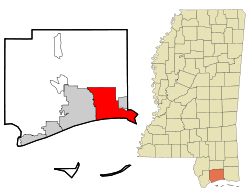 Location in Harrison County and the state of Mississippi. | |
 Biloxi, Mississippi Location in the United States | |
| Coordinates: 30°24′43″N 88°55′40″W / 30.41194°N 88.92778°WCoordinates: 30°24′43″N 88°55′40″W / 30.41194°N 88.92778°W | |
| Country | United States |
| State | Mississippi |
| County | Harrison |
| Incorporated | in 1838 as a township. |
| Government | |
| • Mayor | Andrew "FoFo" Gilich (R) |
| Area | |
| • City | 46.5 sq mi (120.5 km2) |
| • Land | 38.0 sq mi (98.5 km2) |
| • Water | 8.5 sq mi (22.0 km2) |
| Elevation | 20 ft (6 m) |
| Population (2012) | |
| • City | 44,578 |
| • Density | 1,200/sq mi (450/km2) |
| • Metro | 379,582 |
| Time zone | CST (UTC-6) |
| • Summer (DST) | CDT (UTC-5) |
| ZIP code | 39530-39535, 39540 |
| Area code(s) | 228 |
| FIPS code | 28-06220 |
| GNIS feature ID | 0667173 |
| Website | www.biloxi.ms.us |
Biloxi (/bəˈlʌksi/; bə-LUCK-see), officially the City of Biloxi, is a city in Harrison County, Mississippi. The 2010 United States Census recorded the population as 44,054. Along with the adjoining city of Gulfport, Biloxi is a county seat of Harrison County.
The city is part of the Gulfport-Biloxi metropolitan area and the Gulfport-Biloxi-Pascagoula, Mississippi Combined Statistical Area. Pre-Katrina, Biloxi was the third largest city in Mississippi behind Jackson and Gulfport. Post-Katrina, the population of Biloxi decreased, and it became the fifth largest city in the state, being surpassed by Hattiesburg and Southaven.[1]
The beachfront of Biloxi lies directly on the Mississippi Sound, with barrier islands scattered off the coast and into the Gulf of Mexico. Keesler Air Force Base lies within the city and is home to the 81st Training Wing and the 403d Wing of the U.S. Air Force Reserve.
History
Colonial era

The first permanent settlement in French Louisiana was founded at Fort Maurepas, now in Ocean Springs, Mississippi, and referred to as Old Biloxi, in 1699 under the direction of Pierre Le Moyne d'Iberville, with Louisiana separated from Spanish Florida at the Perdido River near Pensacola (founded 1559 and again in 1698).
The name of Biloxi in French was "Bilocci" (with "fort Maurepas"),;[2] on maps dated circa year 1710/1725 the name was sometimes translated into English as "Fort Bilocci".[3][4]
In 1720, the administrative capital of French Louisiana was moved to Biloxi (or Bilocci) from Mobile (or Mobille). French Louisiana (part of New France) was known in French as La Louisiane in colonial times, but in modern times is called "La Louisiane française" to distinguish from the modern state of Louisiana (also "Louisiane" in French).[2]
Due to fears of tides and hurricanes in the 18th century, the capital of French Louisiana was later moved by colonial governor Bienville, in 1723, from Biloxi to a new inland harbor town named La Nouvelle-Orléans (New Orleans), built for the purpose in 1718–1720.
In 1763, following Great Britain's victory in the Seven Years' War, France had to cede French Louisiana east of the Mississippi River, except for New Orleans, to Great Britain, as part of the Treaty of Paris. At that same time, Louisiana west of the Mississippi, including New Orleans, was ceded to Spain as part of the Treaty of Fontainebleau.
Subsequent history
British rule persisted from 1763 to 1779, followed by Spanish rule from 1779 to 1810. Despite this, the character of Biloxi remained mostly French.[5] In 1811, Biloxi came under United States of America control as part of the Mississippi Territory. Mississippi, and Biloxi with it, were then admitted to the union in 1817.
Biloxi began to grow. It became a summer resort, with the advantages of close proximity to New Orleans and ease of access via water. Summer homes were built by well-to-do farmers and commercial figures. Hotels and rental cottages came into existence to serve those who could not afford their own homes.[5]
One of Biloxi's most known features has been the Biloxi Lighthouse, which was built in Baltimore and then shipped south and completed in May 1848.[6] (It and another are the only surviving lighthouses of twelve that once dotted the Mississippi Gulf Coast.[6])
In the early stages of the Civil War, Ship Island was captured by Union forces, which led to the effective Union capture of Biloxi as well. No major battles were fought in the area, and Biloxi did not suffer direct damage from the war.[5] Some local Union sentiment could be discerned following the war's conclusion.[6]
In the postbellum period, Biloxi again emerged as a vacation spot. Its popularity as a destination increased with railroad access. In 1881, the first cannery was built in the town, leading to others soon joining the location. Biloxi grew again, and as different ethnic groups came to work in the seafood factories, Biloxi gained a more heterogeneous population.[5]

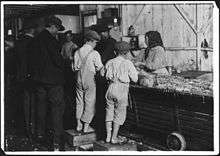
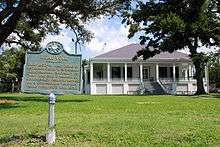
During World War II, the United States Army Air Forces built Keesler Field, now Keesler Air Force Base, which became a major basic training site and site for aircraft maintenance. The Biloxi economy boomed as a result,[7] again bringing more diverse groups to the area. By 1958, the first Jewish synagogue had been built in the town.[7]
Biloxi's casino history dates back to a period in the 1940s, when open, if technically illegal, gambling took place in a casino within the Broadwater Beach Resort.[8] Open gambling ended during the 1950s.[9] The Mississippi Gulf Coast became known as the "Poor Man's Riviera", and was frequented by Southern families interested in fishing expeditions during the summer.[10] Commercially, Biloxi was dominated by shrimp boats and oyster luggers.[10]
In 1959 Biloxi was the site of "Mississippi’s first public assault on racial barriers in its 15-year civil rights struggle"[11] when Gilbert Mason, a physician in Biloxi, went swimming at a local beach with seven other black friends. They were ordered to leave by a city policeman, who told them that "Negroes don't come to the sand beach."[12] This initiated a series of protests led by Mason, known as the Biloxi Wade-Ins. The protests were followed by the worst racial riot in Mississippi history and the death of ten people.[13] Ultimately, the protests led to the desegregation of the beaches of Biloxi.[12]
In the early 1960s, the Gulf Coast again emerged as a prime alternative to Florida as a southern vacation destination among Northerners, with Biloxi a center of the focus.[10] Biloxi hotels upgraded their amenities and hired chefs from France and Switzerland in an effort to provide some of the best seafood cuisine in the country.[10] Edgewater Mall was built in 1963.
With the introduction of legal gambling in Mississippi in the 1990s, Biloxi was again transformed.[7] It became an important center for casinos, and the hotels and complexes brought millions of dollars in tourism revenue to the city. The more famous casino complexes were the Beau Rivage casino resort, the Hard Rock Hotel and Casino (Biloxi), Casino Magic, Grand Casino, Isle of Capri Casino Resort Biloxi, Boomtown Casino, President Casino Broadwater Resort, and Imperial Palace. Like Tunica County in the northern part of the state, Biloxi and the surrounding Gulf Coast region was considered a leading gambling center in the Southern United States.
To celebrate the area's Tricentennial in 1998/99, the city's tourism promotion agency invited the nationally syndicated Travel World Radio Show to broadcast live from Biloxi, with co-host Willem Bagchus in attendance.
By the early 21st century, Biloxi's economy rested on the three prongs of seafood, tourism and gaming.[5]
Hurricanes
Scores of hurricanes have hit the Mississippi Gulf Coast, but the most destructive, as measured by storm surge levels in the Biloxi Lighthouse, occurred in 1855, 1906, 1909, 1947, 1969 (Hurricane Camille), and 2005 (Hurricane Katrina)[14]
Hurricane Katrina
On August 29, 2005, Hurricane Katrina hit the Mississippi Gulf Coast with high winds, heavy rains and a 30-foot (9.1 m) storm surge, causing massive damage to the area. Katrina came ashore during the high tide of 6:56AM, +2.3 feet more.[15] Commenting on the power of the storm and the damage, Mayor A.J. Holloway said, "This is our tsunami."[16] Mississippi Governor Haley Barbour was quoted as saying the destruction of the Mississippi coastline by Hurricane Katrina looked like an American Hiroshima.
On the morning of August 31, 2005, in an interview on MSNBC, Governor Barbour stated that 90% of the buildings along the coast in Biloxi and neighboring Gulfport had been destroyed by the hurricane. Several of the "floating" casinos were torn off their supports and thrown inland, contributing to the damage.
Many churches were destroyed or severely damaged, including St. Michael's Catholic Church (see photo at right), which was gutted by the storm surge, breaking the entry doors and stained-glass windows along the first floor; however, the interior was later removed, and the structure was still solid enough to allow repairing the church.
Hurricane Katrina damaged over 40 Mississippi libraries beyond repair, breaking windows and flooding several feet in the Biloxi Public Library, requiring a total rebuild.[17]
Hurricane-force winds persisted for 17 hours and tore the branches off many coastal oak trees, but the tree trunks survived the 30-foot (9.1 m) flood and many have since regrown smaller branches. Some reconstructed homes still have the antebellum appearance, and miles inland, with less flooding, shopping centers have re-opened.
Harrison County Coroner Gary T. Hargrove told the mayor and City Council that Hurricane Katrina had claimed 53 victims in Biloxi, as of January 30, 2006. Of the 53 confirmed fatalities in Biloxi, a figure that includes one unidentified male, Hargrove said the average age was 58, with the youngest being 22 and the oldest 90; 14 were female and 39 were male.
Biloxi is also the site of a well-known memorial to the Katrina victims, built by the crew and volunteers of Extreme Makeover: Home Edition.[18]
Many casinos were damaged or destroyed by Hurricane Katrina. Of the casinos that were located in Biloxi, eight have reopened since Katrina. They are: the Grand Biloxi Casino Hotel Spa (formerly known as Grand Casino Biloxi), the Hard Rock Hotel & Casino, the Isle of Capri Casino and Resort, the Palace Casino Resort, the IP Casino Resort Spa (formerly known as Imperial Palace), Treasure Bay Casino, Boomtown Casino, and the Beau Rivage, which reopened on the first anniversary of Hurricane Katrina.[19]
Multiple plans have been laid out to rebuild the waterfront areas of Biloxi, and the federal government has recently announced that it is considering giving up to 17,000 Mississippi coast homeowners the option to sell their properties so that a vast hurricane-protection zone can be implemented.[20] Meanwhile, the city of Biloxi is rapidly implementing plans to allow the redevelopment of commercial properties south of highway 90.[21]
-
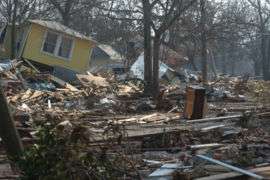
Hurricane Katrina pushed houses inland along the Mississippi Gulf Coast, including at Biloxi.
-

Casino barges floated ashore in Biloxi during Hurricane Katrina's storm surge.
-
%2C_perform_a_search_and_rescue_mission_following_Hurricane_Katrina_in_Biloxi%2C_Miss.jpg)
U.S. Navy personnel perform a search and rescue mission in Biloxi after Hurricane Katrina.
-
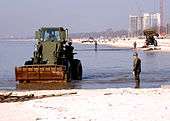
Biloxi beach during cleanup of storm debris.
-

Front view of Beauvoir in Biloxi, 7 months after Hurricane Katrina.
Geography and climate
According to the United States Census Bureau, the city has a total area of 46.5 sq mi (120.5 km2), of which 38.0 sq mi (98.5 km2) is land and 8.5 sq mi (22 km2) (18.27%) is water.
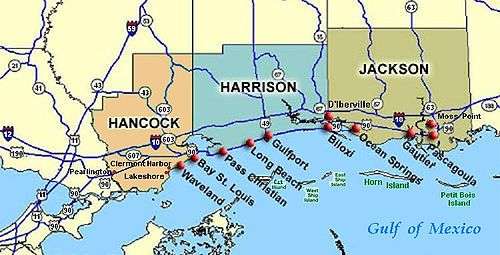
Biloxi has a subtropical climate that is heavily influenced by the Gulf of Mexico. Winter days are mild and wet. Snow is extremely rare in Biloxi. Summers are hot and humid, bearing the brunt of tropical storms during the late summer to fall. Biloxi's record low of 10 °F (-12.2 °C) was recorded on January 24, 1963, and the record high of 104 °F (40 °C) was recorded on August 29, 2000.
| Climate data for Biloxi, Mississippi | |||||||||||||
|---|---|---|---|---|---|---|---|---|---|---|---|---|---|
| Month | Jan | Feb | Mar | Apr | May | Jun | Jul | Aug | Sep | Oct | Nov | Dec | Year |
| Record high °F (°C) | 82 (28) |
80 (27) |
85 (29) |
91 (33) |
98 (37) |
102 (39) |
103 (39) |
104 (40) |
101 (38) |
94 (34) |
86 (30) |
80 (27) |
104 (40) |
| Average high °F (°C) | 60 (16) |
63 (17) |
69 (21) |
76 (24) |
83 (28) |
88 (31) |
90 (32) |
90 (32) |
87 (31) |
79 (26) |
70 (21) |
62 (17) |
76.4 (24.7) |
| Average low °F (°C) | 43 (6) |
46 (8) |
52 (11) |
60 (16) |
68 (20) |
74 (23) |
75 (24) |
75 (24) |
71 (22) |
61 (16) |
52 (11) |
45 (7) |
60.2 (15.7) |
| Record low °F (°C) | 10 (−12) |
14 (−10) |
22 (−6) |
30 (−1) |
45 (7) |
55 (13) |
60 (16) |
61 (16) |
45 (7) |
32 (0) |
25 (−4) |
9 (−13) |
9 (−13) |
| Average precipitation inches (mm) | 5.07 (128.8) |
5.45 (138.4) |
6.11 (155.2) |
4.48 (113.8) |
4.57 (116.1) |
7.07 (179.6) |
7.13 (181.1) |
6.23 (158.2) |
5.58 (141.7) |
3.82 (97) |
4.75 (120.7) |
4.76 (120.9) |
65.02 (1,651.5) |
| Source: [22] | |||||||||||||
Demographics
| Historical population | |||
|---|---|---|---|
| Census | Pop. | %± | |
| 1870 | 954 | — | |
| 1880 | 1,540 | 61.4% | |
| 1890 | 3,234 | 110.0% | |
| 1900 | 5,457 | 68.7% | |
| 1910 | 8,049 | 47.5% | |
| 1920 | 10,937 | 35.9% | |
| 1930 | 14,850 | 35.8% | |
| 1940 | 17,475 | 17.7% | |
| 1950 | 37,425 | 114.2% | |
| 1960 | 44,035 | 17.7% | |
| 1970 | 48,486 | 10.1% | |
| 1980 | 49,311 | 1.7% | |
| 1990 | 46,319 | −6.1% | |
| 2000 | 50,644 | 9.3% | |
| 2010 | 44,054 | −13.0% | |
| Est. 2015 | 45,637 | [23] | 3.6% |
| U.S. Decennial Census[24] 2012 Estimate[25] | |||
Biloxi is the smaller of two principal cities of the Gulfport-Biloxi, Mississippi Metropolitan Statistical Area, which is included in the Gulport-Biloxi-Pascagoula Combined Statistical Area.
As of the census of 2000, there were 50,644 people, 19,588 households, and 12,379 families residing in the city. The population density was 1,331.8 per square mile (514.2/km²). There were 22,115 housing units at an average density of 581.6 per square mile (224.5/km²). The racial makeup of the city was 71.43% White, 19.04% African American, 0.49% Native American, 5.11% Asian, 0.11% Pacific Islander, 1.43% from other races, and 2.38% from two or more races. 3.65% of the population are Hispanic or Latino of any race.
There were 19,588 households, out of which 31.4% have children under the age of 18 living with them, 44.6% were married couples living together, 14.0% had a female householder with no husband present, and 36.8% are non-families. 30.1% of all households were made up of individuals and 10.6% had someone living alone who is 65 years of age or older. The average household size was 2.42 and the average family size is 3.02.
In the city the population dispersal was 24.2% under the age of 18, 14.3% from 18 to 24, 30.3% from 25 to 44, 19.2% from 45 to 64, and 12.0% who were 65 years of age or older. The median age was 32 years. For every 100 females there were 101.9 males. For every 100 females age 18 and over, there were 101.6 males. The median income for a household in the city was $34,106, and the median income for a family was $40,685. Males had a median income of $28,046 versus $21,267 for females. The per capita income for the city was $17,809. 14.6% of the population and 11.2% of families lived below the poverty line. Out of the total population, 19.6% of those under the age of 18 and 11.7% of those 65 and older were living below the poverty line.
In 2005, as a result of Hurricane Katrina, many Vietnamese Americans left Biloxi. In 2009 members of the Vietnamese community in Biloxi said that Vietnamese are coming back to Biloxi due to a poor economic scenario in other parts of the United States.[26]
Economy
Casinos
Biloxi is home to several casino resort hotels, with 24-hour gambling, concert entertainment shows, and several restaurants. Some of the casino resorts include the following (dates reflect business status after Hurricane Katrina):[19]
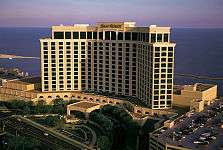
- IP Casino Resort & Spa, reopened on December 22, 2005, formerly Imperial Palace
- Golden Nugget Biloxi, formerly Isle of Capri Casino[27]
- Beau Rivage Resort & Casino, reopened August 29, 2006, on the first anniversary of Hurricane Katrina.
- Boomtown Casino, reopened in 2006
- Hard Rock Hotel & Casino, opened in June 2007
- Harrah's Gulf Coast, formerly Grand Casino Biloxi
- Treasure Bay Casino
- Palace Casino Resort
- Margaritaville Casino and Restaurant, opened May 2012, closed September 2014.[28][29]
Arts and culture
- 2010 saw the grand opening of the new Frank Gehry designed Ohr-O'Keefe Museum Of Art.[30]
 Ohr-O'Keefe Museum Of Art campus in Biloxi
Ohr-O'Keefe Museum Of Art campus in Biloxi - Biloxi is the setting of Neil Simon's play and film Biloxi Blues, which starred Mathew Broderick. Biloxi Blues is the story of army recruits during World War II training at Keesler Field, the present-day Keesler Air Force Base.
- Biloxi is the setting of several John Grisham novels, including The Runaway Jury, The Summons, The Partner, and The Last Juror.
- A substantial portion of Larry Brown's novel Fay is set in Biloxi.
- American singer/songwriter Jesse Winchester once wrote and recorded a song called "Biloxi", for which he was inspired by a few images he saw of the city.
- On his largest-selling regular album, Changes in Latitudes, Changes in Attitudes (1977), Jimmy Buffett included a cover of "Biloxi" (see above); also, a compilation album of his digitally remastered greatest hits was released in 1995 called Biloxi.
- The song "Louisiana", by The Loved Ones, is about the rebuilding of the hurricane ravaged areas on the Gulf Coast. Louisiana, Biloxi, and Alabama are specifically used by name.
- From 1990 to 1994, Biloxi served as home to the Miss Teen USA Pageant.
Sports
| Club | League | Sport | Venue | Founded | Affiliate |
|---|---|---|---|---|---|
| Biloxi Shuckers | SL | Baseball | MGM Park | 2015 | Milwaukee Brewers |
In the center of what fisheries biologists term "The Fertile Fisheries Crescent", Biloxi offers some of the finest sportsfishing along the entire northern coast of the Gulf of Mexico. Spotted seatrout, red drum, Spanish and king mackerel, flounder, snapper, grouper, sharks, and more are all available to anglers during the fishing season. It is not known how Hurricane Katrina affected this ecosystem.
The Huntsville Stars of the Class AA Southern League in Minor League Baseball were sold in January 2014 to an ownership group that plans to relocate the team to Biloxi for the 2015 season at a newly constructed stadium named MGM Park.[31]
Biloxi was the host city of the 2009 Women's World Military Cup.
Biloxi City Futbol Club is set to join the Louisiana Premier League for the fall of 2016.[32]
Government

The Bolton State Office Building in Biloxi includes the headquarters of the Mississippi Department of Marine Resources and the South Regional Office of the Mississippi Department of Environmental Quality.[33][34][35]
The United States Postal Service operates the Biloxi Post Office and other area post offices.[36]
Education
The City of Biloxi is served by the Biloxi Public School District and the Harrison County School District.
The Gulf Coast has a large Catholic school system, of whose schools Biloxi hosts fifteen.[37]
Virginia College has a campus that serves the greater Biloxi/Gulfport area.
Media
Newspaper
Biloxi has one daily newspaper, the Sun Herald, which is headquartered in nearby Gulfport.
Television
According to Nielsen Media Research, the Biloxi market, as of the 2015-2016 season, is the third largest of five television markets in Mississippi, and the 158th largest in the country.[38] Three major television stations serve the Biloxi area. ABC affiliate WLOX 13 and PBS/MPB member station WMAH-TV 19 are located in Biloxi, while Fox/MyNetworkTV affiliate WXXV-TV 25 is located in Gulfport. In addition to the stations' main programming, WLOX and WXXV-TV broadcast programming from other networks on digital subchannels. WLOX-DT2 serves as the market's CBS affiliate, while WXXV-TV operates the market's respective NBC and The CW affiliates on DT2 on DT3.[39]
Radio
20 FM and 7 AM radio stations operate in and/or serve the Biloxi area.
Infrastructure
Transportation
Biloxi is served by the Gulfport-Biloxi International Airport in Gulfport, Mississippi.
Biloxi's main highway is U.S. Highway 90 (Beach Boulevard), which runs along the beach and by the casinos. It connects the city to Gulfport and points westward and to Ocean Springs and Pascagoula to the east. The Biloxi Bay Bridge, connecting Biloxi and Ocean Springs, was rebuilt after Hurricane Katrina, and was fully reopened in April 2008.
Interstate 10 passes through the northern sections of the city, connecting the city to L.A., Phoenix, Tucson, El Paso, San Antonio, Houston, TX, New Orleans, Mobile, Tallahassee and Jacksonville, FL. Interstate 110 splits off from I-10 at D'Iberville and heads south across the Back Bay of Biloxi to U.S. 90 near Beau Rivage, providing the city with an important hurricane evacuation route.
Other highways serving the area include:
- Mississippi Highway 15 (Runs concurrent with I-110 for the first few miles)
- Mississippi Highway 67
Notable people
- Jessica Alba, model and actress. Lived in Biloxi while her father was at Keesler Air Force Base
- Laura Bailey, voice actress
- Matt Barlow, heavy metal singer
- Edward Charles Edmond Barq, entrepreneur and co-creator of Barq's Root Beer
- Alan Belcher, MMA fighter with UFC
- Jimmy Bertrand, jazz drummer
- Malcolm Brown, NFL running back for the Los Angeles Rams
- Hector Camacho, world champion boxer
- Isaiah Canaan, point guard, Philadelphia 76ers
- Gary Collins, actor and television personality
- Jefferson Davis, US Army General and West Point graduate; U.S. Secretary of War (Defense); only President of the Confederate States of America
- Ronald Dupree, professional basketball player
- Leonard Fairley, American football player
- Damion Fletcher, University of Southern Mississippi running back
- Francis Grevemberg, superintendent of Louisiana state police
- Fred Haise, Apollo 13 and Space Shuttle Enterprise astronaut
- Ted Hawkins, singer-songwriter
- Chris LeDoux, country singer
- Barry Lyons, catcher for New York Mets
- James Millhollin, character actor, died in Biloxi in 1993
- Mary Ann Mobley, actress and Miss America
- Francis D. Moran, third director of the National Oceanic and Atmospheric Administration Commissioned Officer Corps
- Jack Nelson, Pulitzer Prize-winning journalist who began career at Biloxi Daily Herald
- George E. Ohr, groundbreaking potter and father of the American Abstract-Expressionism movement
- Charles K. Pringle, attorney and politician
- John Kennedy Toole, author of A Confederacy of Dunces, committed suicide in Biloxi in 1969
- George E. Ohr, artist who broke new ground in 1890s with experimental modern clay forms
- Eric Roberts, Oscar-nominated actor
- Wes Shivers, NFL player for Tennessee Titans and mixed martial artist
- Michelle Anne Sinclair, actress
- Argile Smith, Southern Baptist clergyman and educator, incoming interim president of Louisiana College, former pastor of First Baptist Church of Biloxi
- Brenda Venus, model and actress
See also
- Barq's
- Beauvoir
- Biloxi City Hall
- Dixie Mafia
- Edgewater Mall
- Historic Grand Hotels on the Mississippi Gulf Coast
- List of mayors of Biloxi, Mississippi
- List of tallest buildings in Biloxi
- National Register of Historic Places listings in Harrison County, Mississippi
- Old Brick House
- Pleasant Reed House
- Sun Herald
- Tivoli Hotel
- Tullis-Toledano Manor
- WLOX
References
- ↑ "Mississippi Cities by Population". Mississippi Demographics. Cubit Planning Inc. May 2015. Retrieved September 11, 2016.
- 1 2 "La Louisiane française" (in French), by Virginie Tanlay, from book Histoire de la Louisiane, flfa-enquete7 Archived March 4, 2009, at the Wayback Machine.: states that Iberville chose "le site de Bilocci" (or Biloxi)
- ↑ "Pas-Kaart Van de Golff van Mexico" (map from Amsterdam/1710), Edge of the Map Incorporated, 2007, webpage: Raremaps-Archive-3176.
- ↑ "A New Map of as much of North & South America" (London/1725), Edge of the Map Incorporated, 2007, webpage: Raremaps-Archive-7278.
- 1 2 3 4 5 "Biloxi: A Historic & Cultural Overview". City of Biloxi historical pamphlet, 2003.
- 1 2 3 "Biloxi Lighthouse". City of Biloxi historical datasheet, 2003.
- 1 2 3 "Biloxi/Gulfport, Mississippi" Archived October 5, 2007, at the Wayback Machine., Institute of Southern Jewish Life
- ↑ Wilemon, Tom (2005-06-30). "The Landmark Broadwater Hotel, Once Biloxi's Premier Resort, Shutting Down". The Sun Herald. Retrieved 2008-09-15.
- ↑ Bergeron, Kat. "Before-After: Broadwater". The Sun Herald. Retrieved 2008-09-15.
- 1 2 3 4 Janson, Donald (1963-12-15). "Mississippi Gulf Coast Woos Vacationists". The New York Times.
- ↑ Bill Minor (May 20, 2009). "Watch for 'The Good Doctors' to be out soon". DeSoto Times-Tribune.
- 1 2 J. Michael Butler (February 2002). "The Mississippi State Sovereignty Commission and Beach Integration, 1959-1963: A Cotton-Patch Gestapo?". The Journal of Southern History. 68 (1): 107–148. doi:10.2307/3069692. JSTOR 3069692.
- ↑ "NAACP Denies Biloxi Riot Role". New York Times. April 26, 1960. p. 30.(subscription required)
- ↑ Debbie Stringer. 2010. Biloxi's Guiding Light. Today in Mississippi (Ridgeland, MS), Volume 63, Number 5, May 2010.
- ↑ "2005 NOAA Tide Predictions: Biloxi (Cadet Point), Biloxi Bay" (2005), tide on 29-Aug-2005, NOAA, web: NOAA-tide-tables.
- ↑ http://www.sunherald.com/mld/sunherald/news/special_packages/hurricane_katrina/12514756.htm
- ↑ "Hurricane Katrina Related Damages to Public Libraries in Mississippi" (September 2005), Mississippi Library Commission, web:ALA-Katrina.
- ↑ "Archived copy". Archived from the original on 2007-05-06. Retrieved 2007-04-21.
- 1 2 "Tentative re-opening plans for Biloxi casino resorts" (2006), City of Biloxi, www.Biloxi.ms.us, webpage:Biloxi-Casinos.
- ↑ Gov't May Buy Thousands of Miss. Homes AP via Google News. Retrieved October 17, 2007. Archived October 12, 2007, at the Wayback Machine.
- ↑ Beachfront Development On Biloxi's Front Burner WLOX News. Retrieved on October 17, 2007.
- ↑ "Average Weather for Biloxi, MS - Temperature and Precipitation". Weather.com. Retrieved July 4, 2009.
- ↑ "Annual Estimates of the Resident Population for Incorporated Places: April 1, 2010 to July 1, 2015". Retrieved July 2, 2016.
- ↑ United States Census Bureau. "Census of Population and Housing". Archived from the original on May 11, 2015. Retrieved September 2, 2013.
- ↑ "Annual Estimates of the Resident Population: April 1, 2010 to July 1, 2012". Retrieved September 2, 2013.
- ↑ Thomas, Danielle. "Biloxi Vietnamese say poor economy equals local population rise." WLOX. May 10, 2009. Updated on May 11, 2009. Retrieved on August 14, 2010.
- ↑ Isle of Capri selling Coast casino
- ↑ Perez, Mary (May 22, 2012). "Margaritaville Biloxi opens with a concert heard 'round the country". The Sun Herald. Gulfport, MS. Retrieved 2012-05-23.
- ↑ Margaritaville Casino closes in Biloxi Retrieved 2014-11-02
- ↑ "Archived copy". Archived from the original on 2009-11-16. Retrieved 2011-01-19.
- ↑ "It's official: Huntsville Stars sold, expected to move to Biloxi in 2015". Ballpark Digest. January 11, 2014. Retrieved January 11, 2014.
- ↑ "Biloxi City Futbol Club second expansion team to join LPL for 2016-2017 season". Louisiana Premier League. April 6, 2016. Retrieved April 7, 2016.
- ↑ "Contact Us Archived September 15, 2010, at the Wayback Machine.." Mississippi Department of Marine Resources. Retrieved on November 9, 2010. "Included are the phone numbers of each department within the agency. A map and directions to the Bolton Building can be found here: directions. 1141 Bayview Avenue Biloxi MS 39530."
- ↑ "Directions Archived July 4, 2010, at the Wayback Machine.." Mississippi Department of Marine Resources. Retrieved on November 9, 2010.
- ↑ "South Regional Office." Mississippi Department of Environmental Quality. Retrieved on September 21, 2010.
- ↑ "Post Office Location - BILOXI Archived September 26, 2010, at the Wayback Machine.." United States Postal Service. Retrieved on September 22, 2010.
- ↑ "Archived copy". Archived from the original on 2011-07-25. Retrieved 2010-11-21.
- ↑ Local Television Market Universe Estimates 2015-2016
- ↑ Stations for Biloxi, Mississippi
External links
| Wikimedia Commons has media related to Biloxi, Mississippi. |
| Wikivoyage has a travel guide for Biloxi. |
- Official website
- Biloxi Beach Webcam
- Photographs of Hurricane Katrina's destruction on Mississippi's Gulf Coast from davidmetraux.com
- Photographs and Video of Hurricane Katrina's Aftermath from photosfromkatrina.com
- Ohr-O'Keefe Museum of Art
- City of Biloxi at the Wayback Machine (archived January 10, 1998)
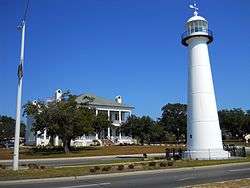
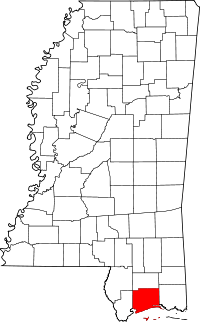
.svg.png)
